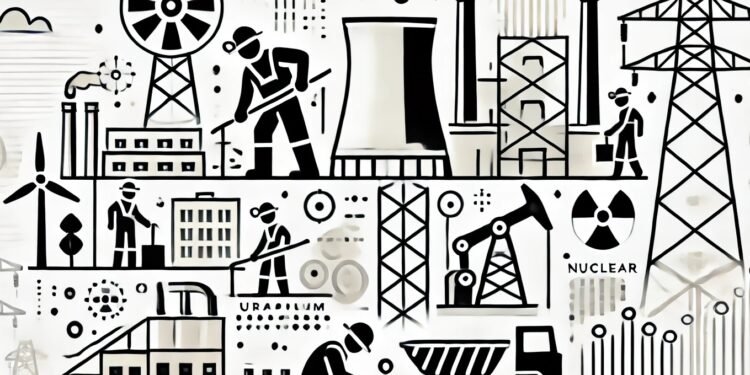Recent Price Surge and Market Dynamics
The uranium market has experienced a remarkable resurgence, with prices nearly doubling in 2023 and continuing their upward trajectory into 2024. This revival pushed the spot price of uranium oxide as high as $106 per pound, reaching levels unseen since 2007, before the Fukushima Daiichi nuclear disaster dampened industry optimism.
Multiple factors have contributed to this price surge, including renewed interest in nuclear energy, increased investment fund activity, and geopolitical concerns over production and access. The September 2023 military coup in Niger disrupted a major uranium source for French company Orano, reducing supplies to France and the broader market. While Niger accounts for only 8% of global uranium output, it supplies nearly a quarter of European demand. Concurrently, technical difficulties have led to decreased production in Canada, further tightening supply.
Geopolitical Influences and Policy Changes
The upward price trend began in 2022, with a 41% increase to $49.81 per pound, driven by potential sanctions on Russian uranium and logistical challenges stemming from the Ukraine conflict. Late 2023 saw additional market impact from speculation about a possible U.S. ban on low-enriched uranium imports from Russia, with the House of Representatives approving a bill that received bipartisan support and was signed into law by President Biden on May 13, 2024. The restrictions were set to begin in 90 days, post May 13, 2024, with waivers available for instances where alternative sources are not available.
Despite these developments, Russian nuclear energy analysts believe that Rosatom’s long-term contracts will help maintain its global market position, even if sanctions are imposed. Rosatom currently leads in global uranium enrichment capacity (35%), ranks second in uranium production (14%), and third in fuel production (17%). In 2023, Russia and Kazakhstan supplied approximately US$1 billion worth of uranium to the United States alone.
Market Structure and Trading Patterns
It’s worth noting that the current growth in spot market prices may not be a strong indicator of overall market conditions. In 2023, spot market activity declined significantly due to active contracting in previous years, with less than 20% of global uranium trade occurring through spot market transactions, compared to over 50% in the previous five years.
As noted in the current spot price, analysts do not expect further sharp growth in uranium prices this year due to existing spare production capacity, particularly in Kazakhstan. Kazatomprom, the world’s largest uranium producer, still has production costs significantly lower than current market prices, although it faces challenges in meeting production targets due to sulfuric acid shortages and construction delays at new mines.
Factors Driving Demand Growth
The perceived ongoing growth in uranium prices is attributed to several factors, including anticipated increases in demand for nuclear energy. Many countries have announced plans to accelerate the development of their nuclear power sectors through the construction of new plants or the extension of existing facilities. The United States, for example, intends to triple its nuclear capacity by 2050, while China, Japan, and France also have substantial new build plans.
Geopolitical situations, such as the conflict in Ukraine, could potentially impact Europe’s uranium supply, as much of Kazakhstan’s exports to the EU transit through the Black Sea. However, analysts believe that even further price increases are unlikely to curb market demand for uranium, given its relatively low cost per kilowatt-hour compared to coal or gas generation.
Industry Response and Capacity Expansion
In response to these trends, analysts expect that sustained incoming higher uranium prices will lead to the resumption of once-stalled uranium production projects. Major global uranium producers are planning capacity expansions this year. Urenco, an enrichment company, has already approved capacity expansions at its sites in Germany, the Netherlands, and the USA, which will provide additional capacity when complete. Orano is also looking to boost its enrichment capacity by 30%.
Rising prices may also encourage countries to accelerate uranium production capacity by reopening mothballed facilities. For instance, Canada’s Cameco is in the process of ramping up activities at its Key Lake mill, despite challenges due to the extended period the facility was in a care and maintenance state.
Long-term Outlook and Market Implications
The prospect of sustained increases in uranium prices seems likely, even if geopolitical challenges were to subside. The global push for new nuclear power plants, the anticipated wave of Small Modular Reactor (SMR) production and deployment, and factors like the return to operations of nuclear plants in Japan provide clear evidence that demand for uranium will continue to grow in the coming years.
While production capacity is expected to rise in response to today’s higher prices, it’s understood that these prices will remain significantly higher than the historic lows seen a decade ago. This new era for the uranium market reflects a broader shift in global energy strategies, with nuclear power playing an increasingly important role in the pursuit of clean, reliable energy sources.
Challenges and Opportunities in the Nuclear Renaissance
As the world grapples with the challenges of climate change and energy security, the resurgence of the uranium market signals a renewed focus on nuclear energy as a key component of future energy mixes. However, this renaissance also brings with it new challenges, including ensuring sustainable and ethical uranium production, addressing nuclear waste management, and navigating the complex geopolitical landscape that surrounds the nuclear fuel cycle.
The uranium market’s current trajectory reflects a complex interplay of economic, technological, and geopolitical factors. As demand for nuclear energy grows and supply chains adjust to new realities, stakeholders across the industry will need to remain vigilant and adaptable to ensure a stable and sustainable future for nuclear power and the uranium market that fuels it.
Conclusion: The Future of Uranium and Nuclear Energy
In conclusion, the uranium market’s resurgence represents a significant shift in the global energy landscape. As countries worldwide seek to decarbonize their economies and ensure energy security, nuclear power is increasingly seen as a vital part of the solution. The sustained high prices of uranium are likely to drive innovation in mining and processing techniques, potentially leading to more efficient and environmentally friendly extraction methods.
However, the industry must also address ongoing concerns about nuclear safety, waste management, and proliferation risks. The development of advanced reactor designs, including SMRs and Generation IV reactors, may help alleviate some of these concerns while also potentially changing the dynamics of uranium demand.
As the market evolves, it will be crucial for policymakers, industry leaders, and investors to closely monitor global trends and adapt their strategies accordingly. The future of the uranium market will undoubtedly play a significant role in shaping the world’s energy future, making it a critical area of focus for years to come.
Acknowledgment: This article was inspired by and includes information from "Uranium Price Trends Sending Market Signals" published on Neimagazine.com. For more detailed insights, you can read the full article here.







